Cuyahoga Valley National Park in Ohio is truly a unique mixture of city attractions and rural life, where history is preserved amid today’s hectic existence. It’s a fantastic place to go if you want to camp, and even if you have an RV and can’t camp right in the park, there are plenty of places nearby that offer camping accommodations.
With that in mind, let’s dig into what makes Cuyahoga Valley National Park so special.
Why Visit Cuyahoga Valley National Park in an RV?

Cuyahoga Valley is unusual in that it lies between two urban areas and is crisscrossed by metropolitan attractions and amenities. RVs make a perfect home when parked in any of the nearby campgrounds. When RVing, you can access the region by walking, biking or even riding the train. There’s plenty to do and see here, so you should take the time to make the most of it.
It’s the park’s location that makes it such a wonderful Midwestern destination to visit. Are there other fantastic places to camp in the Midwest? Yes, of course, but there’s no other place out there like this unique national park. Ohio has a real gem in this park, although it’s one that is often overlooked in favor of the other more-common national parks, you will never regret spending time at Cuyahoga Valley National Park.
When to Visit Cuyahoga Valley National Park
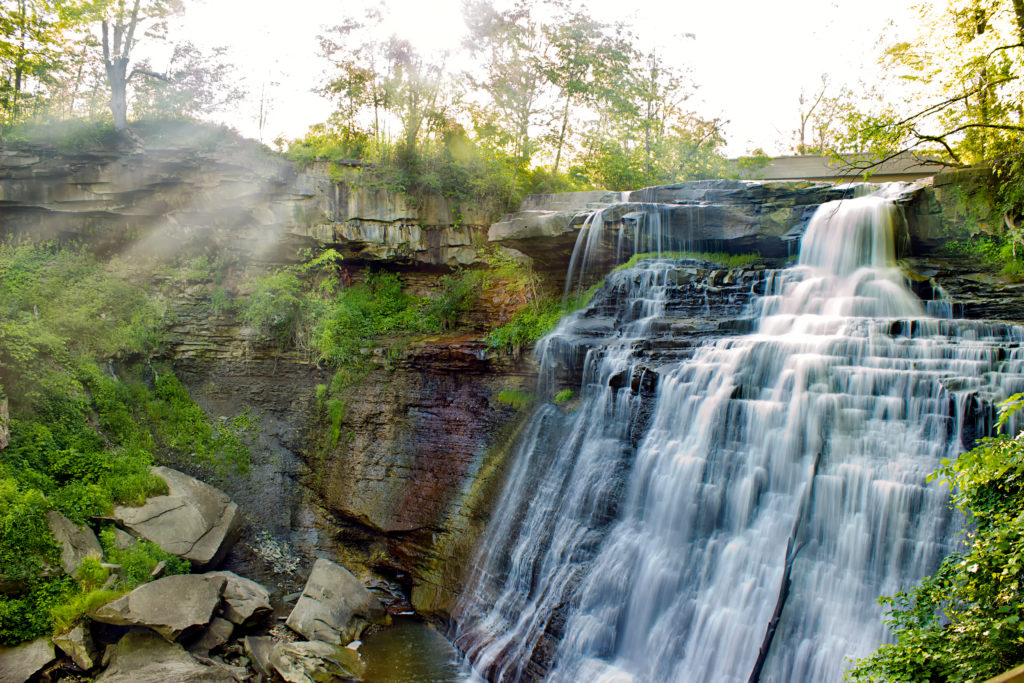
Image: Shutterstock
The park is open year-round, some places close at dusk, but everything else is open 24 hours a day. As with any destination, check the operating hours before visiting to ensure you’re visiting within any fluctuating seasonal schedules.
Cuyahoga Valley National Park in the Spring
Visiting the park in the spring allows visitors the opportunity to see new leaves on trees and blooming wildflowers, while the warming temperatures welcome an increase of hikers on the trail.
Cuyahoga Valley National Park in the Summer
The summer temperatures range from 49-degrees at night to 95-degrees during the day and can be rather humid. It’s best to dress in layers so you can adjust to the changing temperature throughout the day.
Cuyahoga Valley National Park in the Fall
The fall foliage tends to peak around mid-October, so plan your visit around that time to get the best views of the park as it shifts seasons. Fall temperatures range from the low 70s during the day to freezing at night.
Cuyahoga Valley National Park in the Winter
Visiting the park during the winter is great, but a day trip is usually recommended. Because Lake Erie is nearby, the winter weather conditions can rapidly change from day to day with temperatures varying from the mid-30s to below zero.
Where to Stay
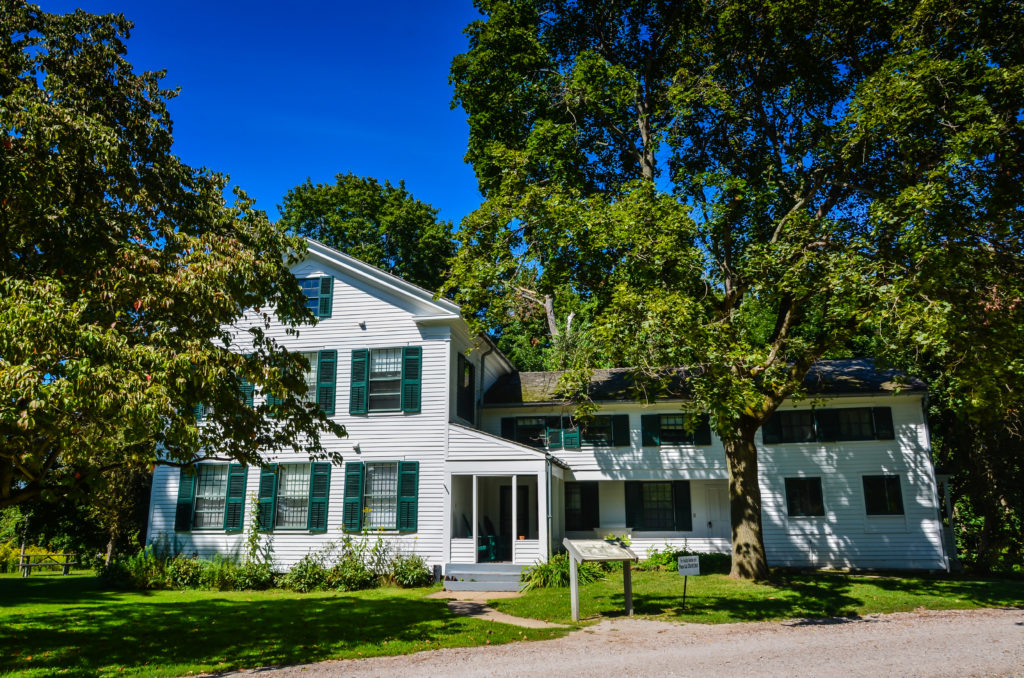
Image: Sandra Foyt / Shutterstock
Unfortunately, you can no longer camp within the park. However, there are four metro and state parks within the area that offer RV sites.
- Nimisila Reservoir Metro Park
- Punderson State Park
- Portage Lakes State Park
- West Branch State Park
If you really want to stay within the park, there are a few lodging options: the Stanford House or The Inn at Brandywine Falls. Both offer top-notch accommodations, though it’s nothing like the camping RV enthusiasts know and love.
Staying Outside the Park
There are, however, several campgrounds nearby (all within 25 miles of the park) that cater to visitors traveling in their RVs.
- Roundup Lake Campground
- American Wilderness Campground
- Woodside Lake Park
If you’re not a Good Sam member, it’s worth investing in a Good Sam Membership to save 10% on nightly stays at all Good Sam Campgrounds — including the three mentioned above.
Tips for Your Camping Stay
The Cuyahoga Valley National Park does have limited parking spaces for oversized vehicles. They have, however, designated an RV and Trailer Parking area across from the Boston Mill Visitor Center where RVs can park.
There is more parking available in these areas during non-peak hours and parking is for use during the day only. Overnight RV parking is not allowed anywhere in the park.
How to Get Around Cuyahoga Valley National Park
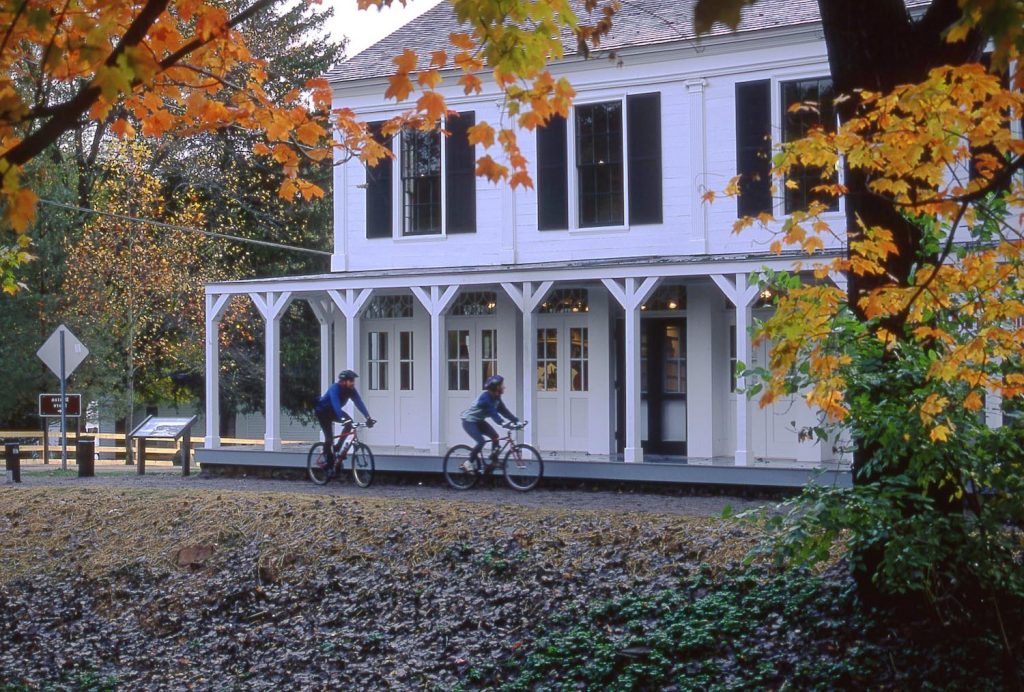
From the south, the park is accessible 18 miles from Akron via I-77 and Highway 8. From the north, travelers from Cleveland can travel I-77 south to Highway 21. The Boston Mill Visitor Center marks the entrance to Cuyahoga Valley National Park and is located in the center of the park.
Once inside, there are numerous roads, as this park sits among several outlying towns and districts. There are many forms of transportation to see the public and private attractions within the park, such as bicycling and walking or riding the Cuyahoga Valley Scenic Railroad.
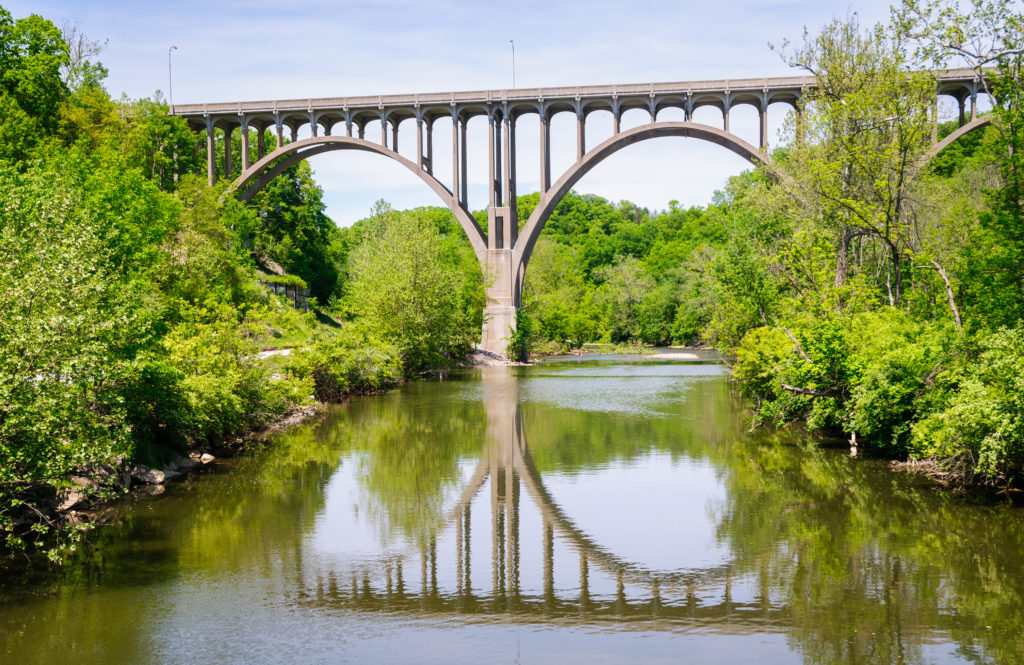
Image: Shutterstock
You can take a scenic train ride through the valley to discover a river tamed almost 200 years ago, with locks and canal boats moving precious cargo to Lake Erie and on to the East Coast long before semis and airplanes came on the scene. You can kayak the now clean waters that burned, not once but twice, from pollution years ago and wonder at the great blue heron who raise their young in this piece of paradise caught between two cities.
While the train ride is the best way to see the length of the park from an amazing vantage point, it does only run Wednesday through Sunday from July to November. Tickets range from $11-$36 and seating options include coach, tabletop, or executive. Visit the National Park Scenic Excursion site for more details.
Places to Go
The park is large, at well over 50 square miles. With that in mind, you’re bound to find plenty of unique places within the park’s boundaries to explore. However, there are some places you must visit if you go. Don’t miss out on any of these opportunities in the park!
Cuyahoga Valley Scenic Railroad

As mentioned above, the train ride is the best way to see the park. Let the engineer do all the driving while viewing the national park from the seat of the Cuyahoga Valley Scenic Railroad. A 2-1/2 hour trip will take riders past many of the highlights of the area while following the Cuyahoga River. Passengers can board and deboard at three different stops to do further exploring along the way.
Ohio & Erie Canal Towpath Trail
Hike, bike, or run on the packed gravel Towpath Trail, which follows the old Ohio and Erie Canal. The 85-mile-long trail runs from Cleveland, and when finished at 101 miles, will end in North Philadelphia. It’s a great way to get a good workout in while taking in all that this park has to offer.
Brandywine Falls

One of the most popular attractions at Cuyahoga Valley National Park is this 65-foot-tall waterfall. When the area was first settled, a sawmill was built at the top of Brandywine and later grist and woolen mills utilized the falls’ power.
They’re an absolute must-see and one of the best photo opportunities in all of Ohio and much of the Midwest. If you’re with your family, make some time to visit and to take in the falls in all their glory.
Boston Mill Visitor Center
As the park’s main visitor center, Boston Store has a gift shop, restrooms, and exhibits showcasing canal boat building in the valley. The place itself isn’t wildly impressive, but it’s somewhere worth stopping. It can also make a smart location to base all your park activities out of. This is especially true if you plan on taking part in any of the ranger-led tours, which come highly recommended.
Canal Exploration Center
Purchase goods from the Canal Era at the Canal Exploration Center and try your hand at guiding a canal boat through a lock with interactive touch screens. If you want to bring an educational aspect to your trip, which can make for a more memorable trip overall, then you should stop in. The interactive site will go into why canals are important and what function the site itself served.
Hunt House
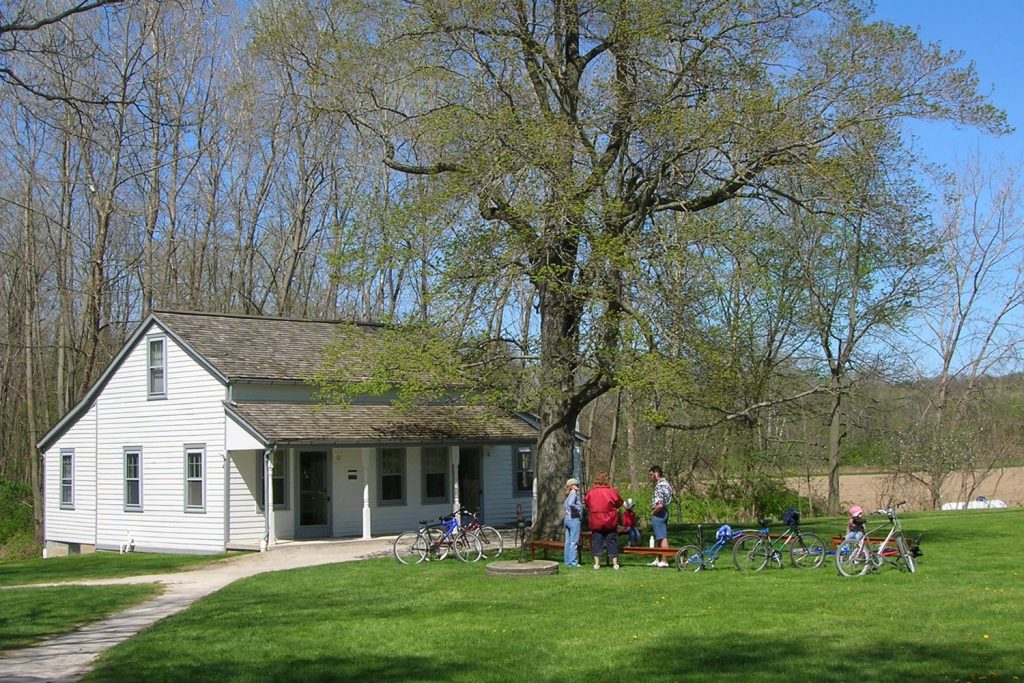
Kids will love the nature exhibits at Hunt House, and adults will be grateful for a rest break. It’s a wonderful place to sit back and relax for a few moments before moving on to the next location.
The Hunt House is along the canal towpath trail, so you may want to take some time and relax here after hiking, running, or biking. It operates seasonally, so make sure to check the schedule before visiting.
Things to Do in Cuyahoga Valley National Park
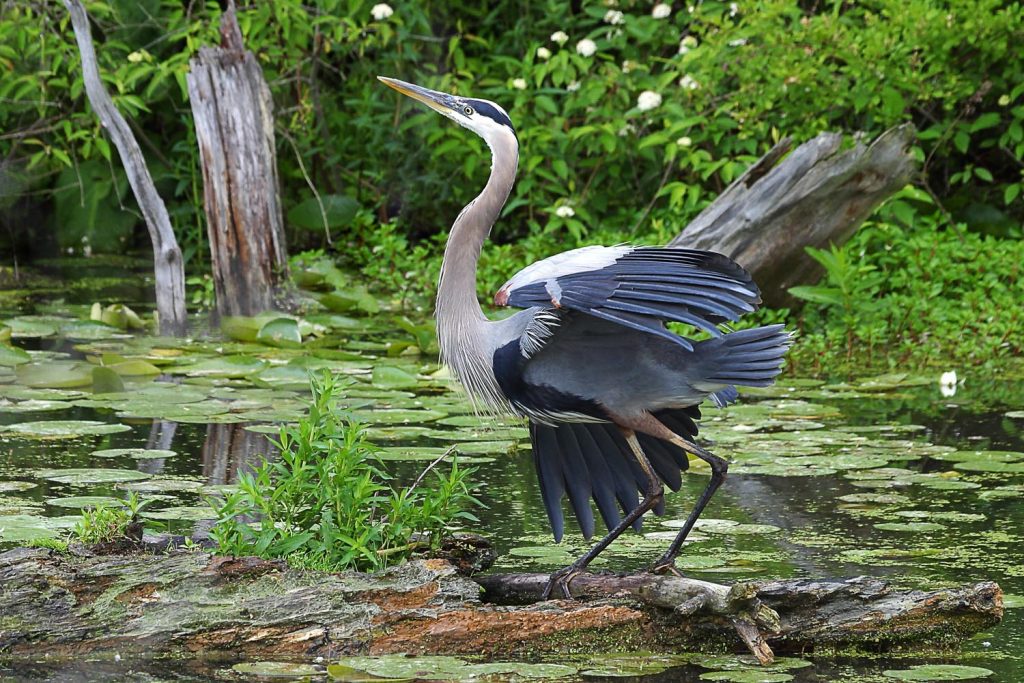
There are several ways to enjoy the park, many of which have been mentioned above, but check out the list below as there’s something for everyone to do when visiting.
Hiking
There are over 125 miles of hiking trails throughout Cuyahoga Valley. Many are accessible to all visitors, and several regional trails run through the park, as well, like the Ohio Buckeye Trail. Find detailed information about each trail in the park, including the length, surface type, elevation changes, and more here.
It’s worth it to look over the trails before you go and select a few areas you’d like to hike. Have a plan before you show up at the park. This will not only help you hike the trails you want, but it will help you decide what to bring with you in terms of snacks, water, etc.
Biking
Ride along the Towpath Trail in either direction. If you get tired, you can catch the Cuyahoga Train at any stop. This helps make things easy and allows you to bike as far as you want and then be able to take some time to relax on the train when needed.
Mountain biking is also popular on the East Rim Trail System. If you’re interested in more than just riding along the Towpath Trail, then this is the place to go. The trail system is a little more advanced and extreme.
Fishing

The Cuyahoga River is home to numerous steelhead, trout, and bullhead. Catch-and-release is suggested to keep the fish population healthy. There are also many lakes and ponds throughout the area that offer bluegill, bass, and crappy wherever you cast a line. Fishing is allowed in the park, but make sure you have an Ohio fishing license on-hand. Licenses are inexpensive and the money goes back into the parks system in most cases.
Canoeing & Kayaking
The national park does not maintain the river for recreational use, but it is open to anyone bringing their own canoe or kayak. There are five different access points throughout the park. However, don’t blindly jump on the river with your kayak or canoe. Make sure to check the website and see if there are any warnings or issues you need to be aware of.
Another way to enjoy the river is through companies that offer river experiences. There are several that will rent a canoe or kayak. These companies take care of everything from dropping you off to picking you up. There are various trips you can take, and they vary in length. Paddle the River is one that offers a few different options.
Horseback Riding
Cuyahoga Valley has many different bridle trails within the park boundaries. Bring your own horse, as there is ample trailer parking at the Station Road parking lot. Horseback riding is permitted only on trails designated by signs as “horse trails”. For more information about bridle trails and their locations, visit the horse trails site.
Questing
Follow a map and clues to discover natural and historical gems throughout the park. A GPS isn’t needed! Although this is something you’ll have to do of your own volition, it’s well worth it. Set various goals for yourself throughout the park and see if you can get to all the places on your list. You can also think about Geocaching. There are geocaches within the park.
Snowshoeing
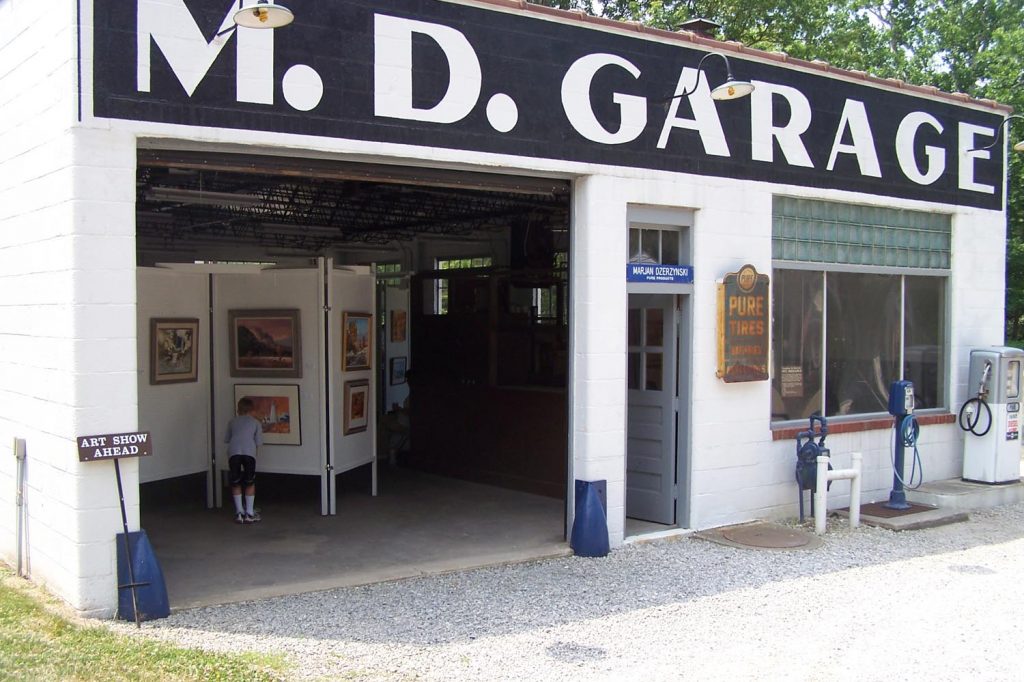
Yes, the park is open during the cold winter months. And yes, it’s still a great time to visit. There’s plenty to do and certain areas of the park are even more enjoyable and beautiful in the winter.
Grab some snowshoes at the Winter Sports Center at M.D. Garage and wander the trails after a good storm has deposited at least six inches, or more, of snow. Any less and your regular snow boots will get the job done.
What to Bring and How to Prepare
Since camping inside the park isn’t an option, you’ll need to bring any necessities with you that you would find yourself returning to your campsite to use. However, there are places to eat in the park.
For snacking, there are two Trail Mix Stores run by the Conservancy for Cuyahoga Valley National Park that offer various snacks including ice cream, as well as books and merchandise. For dining, there are several restaurants located throughout the park. There are picnic areas scattered along the park as well. While all have tables available on a first-come, first-served basis, only a few provide grills.
Always dress in layers since the weather tends to fluctuate throughout the day. It’s better to be prepared for a shift in temperature so your visit isn’t cut short by a warmer or colder day than expected.
History of Cuyahoga National Park
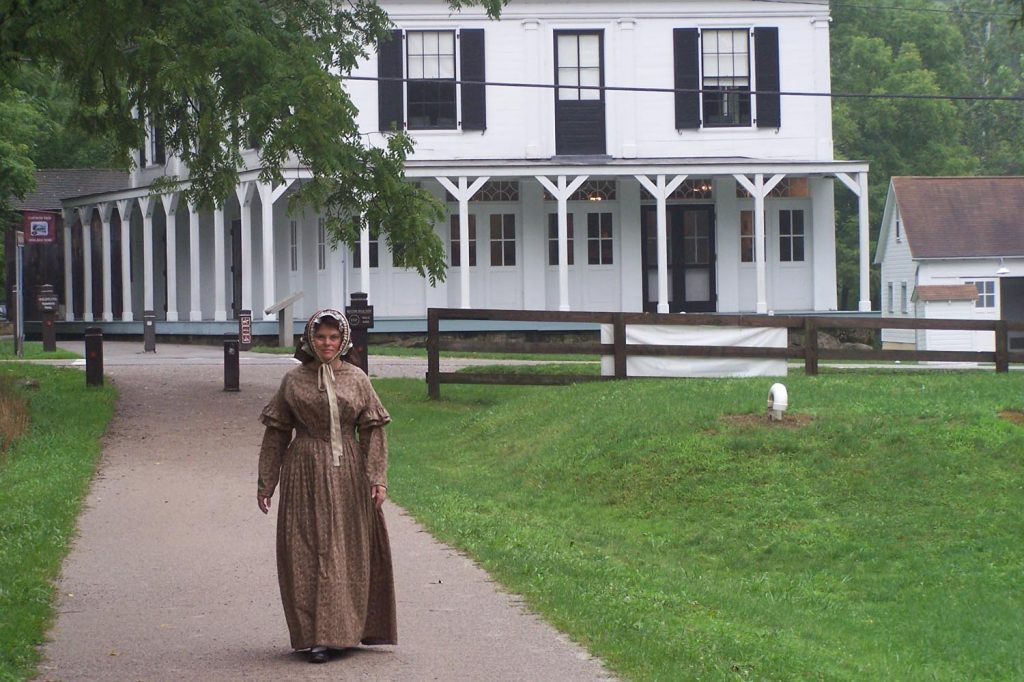
The early habitation of the Cuyahoga Valley included several Native American tribes, who moved in and out of the region. By the mid-1700s European explorers began to build trading posts in the area, eventually enticing New England settlers to spread throughout Ohio.
The settlements grew into productive cities, looking for a way to get their products to the markets back east. In the 1830s, the Ohio & Erie Canal was built, connecting Akron, OH with Lake Erie via the Cuyahoga River.
Within 50 years, as the industry grew in urban centers, city dwellers looked to escape to rural regions for their recreation — including the land along the Cuyahoga River. By 1880 the Valley Railway began bringing “tourists” to the area for boat trips on the canal.
When Cleveland and Akron established their own park districts, locals began to think about preserving the area between the two cities, limiting development. In 1929, Hayward Kendall left 430 acres to be perpetually used for park purposes in the area, essentially beginning the formation of Cuyahoga Valley National Park.
It took 45 years and a great deal of cooperation among cities, private attractions, and the park service, but this unique national park gained official status in 1974. Today it combines metropolitan regions with historic waterways, forestlands, and wildlife, giving visitors an example of yesteryear still in progress.
Plan your next trip to the national parks in an RV. Rent an RV, trade-In your RV, or buy an RV and start traveling for less than $5 a day.
Have you been to Cuyahoga Valley National Park? If so, what’d you think? Leave a comment below.
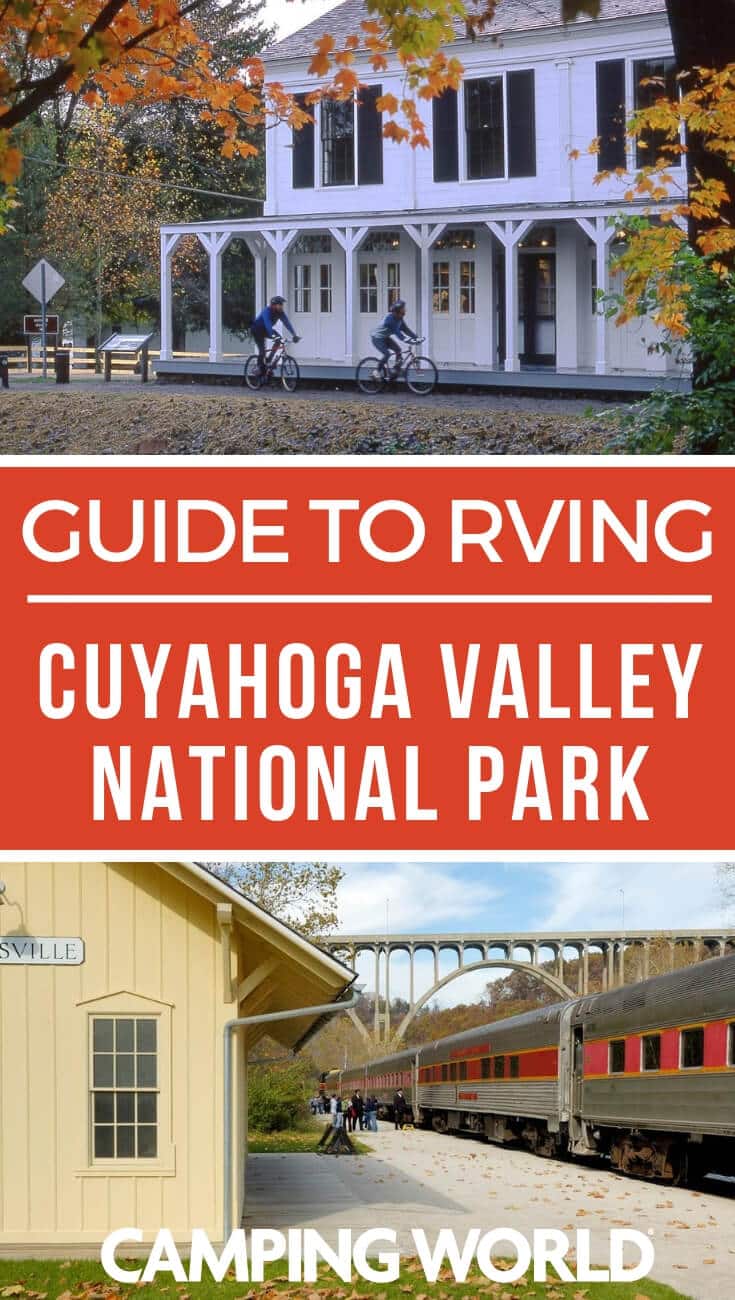
By: Shelley Dennis
Title: Camping World’s Guide to RVing Cuyahoga Valley National Park
Sourced From: blog.campingworld.com/the-rv-life/where-to-go/camping-worlds-guide-to-rving-cuyahoga-valley-national-park/
Published Date: Fri, 19 Aug 2022 15:00:48 +0000
---------------------------------------------
 CampingSurvivalistHuntingFishingExploringHikingPrivacy PolicyTerms And Conditions
CampingSurvivalistHuntingFishingExploringHikingPrivacy PolicyTerms And Conditions
